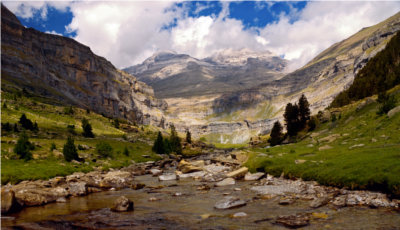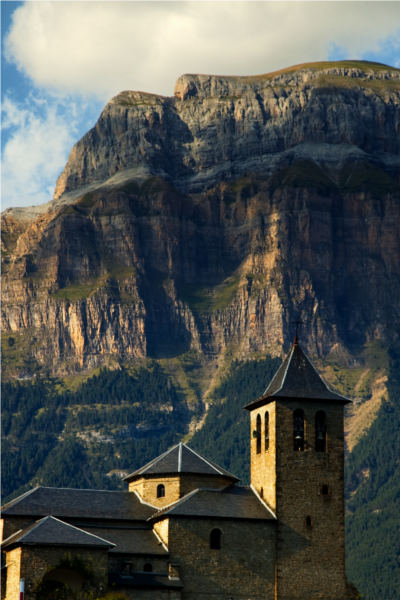Established in 1918 the Parque Nacional de Ordesa y Monte Perdido was Spain's first protected area and is an undisputed highlight of the Pyrenees. In 1997 the park was declared a UNESCO World Heritage Site.
The park is best known for it's dramatic valley and canyons. The Ordesa and Pineta valleys are kilometre deep glacial valleys while the Anisclo Canyon and Gargantua de Escuain were formed by the Rio Bellos and Rio Yaga respectively.
 At 3355m the limestone summit of Monte Perdido is the parks highest peak (and the third tallest in the Pyrenees) and the park contains a dozen other summits of over 3000m.
At 3355m the limestone summit of Monte Perdido is the parks highest peak (and the third tallest in the Pyrenees) and the park contains a dozen other summits of over 3000m.
Geography
A karstic limestone layer covers the park. This layer was lifted from the sea bed fifty million years ago and was tilted and folded as it rose. Glaciers then carved the landscape creating the dramatic peaks and the steep sided valleys. As the limestone layers have eroded, ledges have been created in the cliffs. Some of these are walkable and these paths (called 'Fajas') are some of the most dramatic in Europe.
Highlights
The Ordesa Valley is the most dramatic in the park with cliffs of over eight hundred metres on each side and Monte Perdido perched majestically at the valleys end. The cliffs of the Anisclo Canyon may not be as high but the narrow, winding nature of the valley makes it just as spectacular.
Walking in the park
The Ordesa National Park has some of the best hiking in the Pyrenees. It's varied terrain means there are superb trails for walkers of all levels.
If you like gentler hikes and rambles there are great trails along both the Ordesa and Anisclo valleys. Good tracks follow the valley floor alongside clear blue rivers interspersed with waterfalls. High cliffs flank you on either side. In Ordesa the path starts among beech and birch woods which open up to meadows that are filled with flowers in early summer. The trail ends at the waterfall in the Circo de Soasa with Monte Perdido dominating the skyline above.
 Those with good hiking experience can attempt Monte Perdido the highest summit in the park. First spend a night at Refugio Goriz which is fantastically located at the foot of Perdido with views down into the Ordesa Valley. The following morning make an early start up the popular trail to the summit for fantastic views. Be aware this is a high mountain route covered in ice and snow throughout most of the year and crampons, iceaxe and experience in using them are required.
Those with good hiking experience can attempt Monte Perdido the highest summit in the park. First spend a night at Refugio Goriz which is fantastically located at the foot of Perdido with views down into the Ordesa Valley. The following morning make an early start up the popular trail to the summit for fantastic views. Be aware this is a high mountain route covered in ice and snow throughout most of the year and crampons, iceaxe and experience in using them are required.
Wildlife
Colonies of Griffon Vultures roost high in the cliffs of the Anisclo Canyon. This massive bird has a wing span of several metres and groups are easily seen rising on the thermals created by the sun beating on the rock faces. They often fly in close formation in twos, threes or fours and make a magnificent sight as the sweep overhead searching for food.
The Ordesa valley is home to Sarrios (Pyrenean Chamois). Growing to just eighty centimetres with short horns these shy animals congregate in the upper slopes to graze in the summer. Almost hunted to extinction, Sarrio are now protected and thrive in many Pyrenean valleys.
One of the rarest and spectacular vultures - the Lammergeier (or Bearded Vulture) can often be seen in the park. The Spanish Pyrenees are home to approximately 55 breeding pairs - the largest population in Europe. The Lammergeier uses it's incredible wingspan to cover huge distances searching for food. This vulture is most famous for the unique behaviour of dropping bones from a great height to smash them open and expose the nutritious marrow inside.
The park is also home to 5 breeding pairs of Golden Eagles. This elegant bird of prey, while smaller than the Griffon Vulture, is majestic and expert in the air.
Visiting the Park
The pretty town of Torla is known as the gateway to the park. From Torla you are just a 10 minute drive to the start of all of the walks in the Ordesa Valley. There are hotels and restaraunts to suit all budgets as well as shops, banks and small supermarkets with all the necessaries for pack lunches. Torl and the park do get busy during the summer holidays - particularly in August. During July and August cars are banned from entering the park and a very efficient shuttle bus service operates from the vistors centre in Torla (4.50E for the return trip).